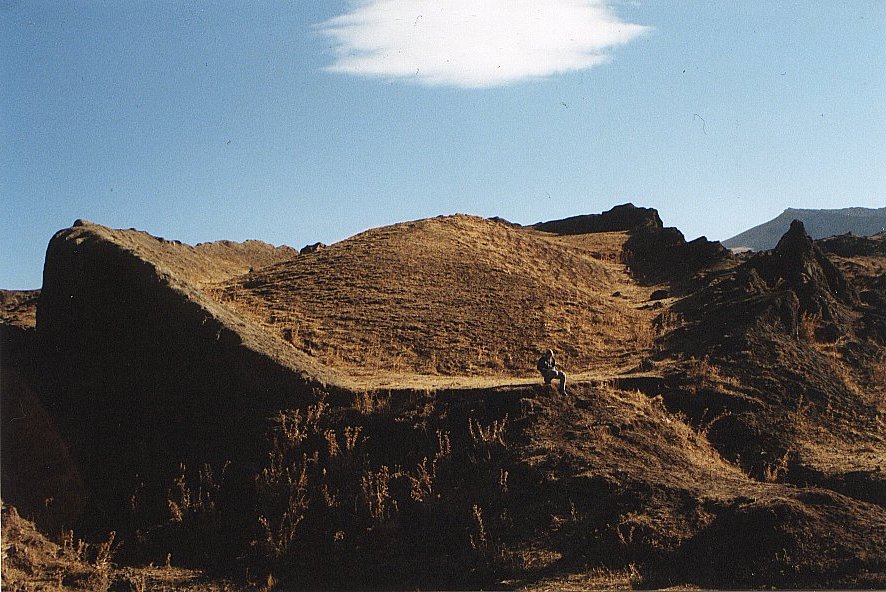The towering summit of Ararat remained unconquered until the 19th century, for monks believed that no one should attempt to reach the ‘sacred top’ where the remains of Noah’s Ark were said to rest. The dazzling summit of Mount Ararat, capped by a permanent layer of glistening snow, soars towards the heavens like a magnificent silver-beaked bird.
The peak that is known locally as Agri Dagi, ‘the painful mountain’, rises in solitary splendor from the plain of the River Aras, providing a dramatic contrast to the dusty, rugged surrounding landscape. Mount Ararat’s fame rests not on the natural beauty of its symmetrical, deceptively smooth flanks and brilliant white crest, however, but on its Biblical associations, for this mountain is held to be the first to have pierced the receding waters of the Great Flood and offer a safe berth for Noah’s Ark.
According to Genesis, God chose the 600-year-old Noah to be saved because he was a ‘just man’. He gave precise instructions: the Ark was to be made of gopher wood and lined inside and out with pitch so that it would be water-resistant. It was to be 300 cubits long, 50 cubits wide and 30 cubits high. (A cubit, traditionally the average length of a man’s forearm from the elbow to the tip of the middle finger, was equal to about 18in/45cm.)
Noah, with his wife, his three sons, Shem, Ham and Japheth, and his sons’ wives were the only members of the human race God thought worthy of survival.
One of the epithets that has been applied to Ararat refers to its size: ‘the Armenian Giant’. The mountain dominates its surroundings, in terms of both its height and bulk, measuring some 25 miles (40km) in circumference. Ararat is not only beautiful, it also brings considerable benefit to the land at its feet. Meltwater from the peak flows freely down the hillsides, making this part of the Anatolian plain, near the boundaries of Turkey, Iran and Armenia, abundantly fertile.

Mount Ararat in fact comprises two peaks 7 miles (11km) apart and connected by a rough-topped ridge: Great Ararat – at 16,854ft (5137m) the highest mountain in Turkey – and Little Ararat, 12,782ft (3896m) above sea level. Both are volcanic in origin, and composed of layers of ash and lava, although there is no longer any sign of a crater on either summit. The flanks, however, are still covered in the small cones and fissures usually associated with volcanic activity. Many of the rocks of the valley floor are likewise partly composed of ash.
The upper and lower slopes of Mount Ararat are largely barren. Despite a permanent snowline at around 14,500ft (4420m), water is scarce on the mountain and a few birch trees are the only vegetation that can survive. Around the middle slopes, however, from 5000 to 11,500ft (1500 to 3500m), the terrain is lusher, and Kurdish farmers graze their sheep on the good pastureland. Few other animals make their home here, although there were certainly greater numbers in the early 19th century when the visiting British diplomat James Morier, reported ‘bears, small tigers, lynxes and lions’. Wild cats and snakes may have inhabited the mountain in medieval times, giving rise to rumours of dragons, but colourful local tales of small snow worms so cold they were able to cool a large bowl of sherbert have never been substantiated.
These legends of fantastic beasts roaming its slopes may well have been contributed to Mount Ararat’s reputation as unclimbable. Its daunting mystical aura and the physical hazards involved, which included avalanches, blinding mists, falling boulders and sudden, severe changes in the weather, meant that it was not scaled until 1829, when Johann Jacob von Parrot, a 37-year-old German professor, reached the summit at his third-attempt. He celebrated his achievement by planning a wooden cross there. Others followed, including, in 1876, the British scholar and statesman James Bryce. Gazing from the summit across the dusty plain to territories ruled for centuries by tsars, shahs and sultans, he was overwhelmed by a sense of history and declared: ‘If it was indeed here that man first set foot on the unpeopled earth, one could imagine how the great dispersal went as the races spread themselves down from these sacred heights…. No more imposing centre of the world could be imagined.’

Mount Ararat’s mystical reputation stems from from the Bible. God, so disgusted by the wickedness of the human race that he decided to wipe it out with a cataclysmic flood, spared only the righteous Noah, his family and a male and female specimen of every bird and animal – all of whom sheltered n a great ark. ‘And in the seventh month, on the seventeenth day of the month, the ark came to rest upon the mountains of Ararat’ (Genesis 8:4). Once the waters subsided, Noah, his family and the animals left the vessel.
The Bible is not specific about which mountain of the ancient land of Ararat was the resting place of the Ark. The legends of the Armenian and Persian peoples living in this area of eastern Turkey, and predating the Christian era, firmly place the landing site at Agri Dagi. The Armenians believed that they were the first people to populate the Earth after the Flood, while the Persians called the land around Ararat the ’cradle of the human race’.

Sightings of the Ark on the mountain have been recorded since the fifth century BC, when Chaldean (Babylonian) priests are said to have scraped the carbon coating from pieces of wreckage. Medieval travelers brought back tales of having seen relics of the Ark, and over the centuries additional claims of sightings have been made. Bryce himself discovered a possible relic: ‘amid blocks of lava, a piece of wood about four feet long and five inches wide, which had obviously been shaped by means of a tool’. In 1916, a Russian pilot flying over the mountain reported seeing the remnants of a large ship. Tsar Nicholas II sent out a search party, which returned with notes and photographs, all of which disappeared during the Russian Revolution.
Scientific examination – including carbon dating – of existing wooden fragments indicates that none of the remains is old enough to date back to Noah. One theory proposes that they are all that is left of a centuries-old monastery (once a place of pilgrimage), destroyed by an earthquake in 1840. No conclusive physical proof of the Ark’s existence has yet been found. Ararat continues to enthrall those who witness its splendor nonetheless: in the words of James Morier, writing in 1818: ‘It is perfect in all its parts….everything is in harmony.’
-end-




































